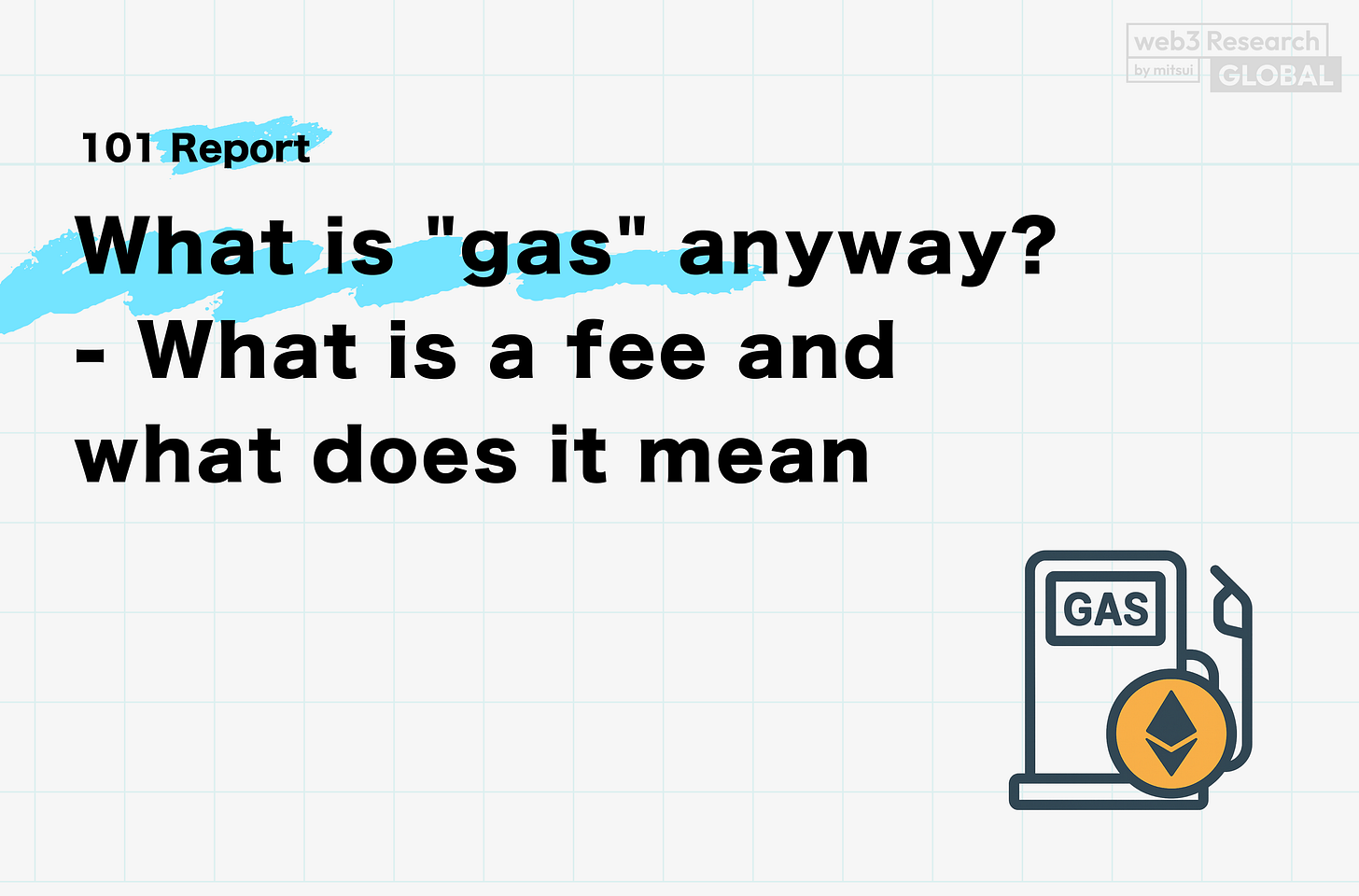What is "gas" anyway? - What is a fee and what does it mean【Part 1】
This section explains the fundamental concept of the blockchain, the "gas fee," from the basics.
Good morning.
Mitsui from web3 researcher.
Today's report is a basic report on the basics of web3, so we're going to take a deeper look at "gas costs".
What you will learn
Be able to understand what the GAS fee is, how it works, and how it is calculated:Understand the logic behind why a fee is charged for each transaction sent.
Who pays the GAS fee and who receives it?: We can understand the incentive structure to keep the network secure.
Decipher the "ideology" and "economic design" of the blockchain from a gas perspective:L2 and other chain (e.g. Solana) mechanisms will also be compared to learn what the gas generation essentially supports.
Currency Value and "Forced Demand": From a tax and monetary theory perspective, "the gas price is what makes the token valuable"We understand the idea that.
Future Prospects/Optimization:Understand why reducing gas bills and improving scalability are important, including L2 solutions and sharding.
Let the first part begin.
First: Why do we have to pay for "gas"?
1. What is gas? ~ "fuel" metaphor
2. gas formula ~ "gas limit x gas price = commission"
3. who receives the gas - transition from PoW to PoS
4. actual gas cost - transaction weight in the case study
5. why gas costs are rising - balance of supply and demand
6. gas is"not just a cost" - the fuel that supports network security
Summary.
🧵TL;DR
In blockchains such as Ethereum, the cost of maintaining a decentralized network is made visible in the form of a "gas fee", which is borne by the users themselves.
This is also a mechanism to prevent spam and reward nodes at the same time by allocating the cost of server operation to each individual node, which in the web2 era was shouldered by the companies.
The gas fee brings a forced demand for tokens, and after the transition to PoS, it also contributes to the backing of token value by rewarding validators and burns.
The fee is expected to decrease in the future with the introduction of L2 solutions and sharding, but gas itself is a core element that supports network fairness and security.
Introduction: Why do we have to pay for gas?
When you use a blockchain, especially a network such as Ethereum, to perform a transaction (such as a money transfer, an NFT mint, or a transaction on DeFi), you have to pay a fee called a "gas fee".Many people who are new to this ask, "Why do they charge me so much for every money transfer?""Why can't I do it for free, like posting on social networking sites?"I question.
However, if you stop and think about it, even web2 (conventional Internet) services that appear to be "free" have to incur server maintenance, development labor costs, electricity costs, and so on.Companies cover these costs through advertising and billing models.In other words, it is not actually free, but rather "paid for invisibly.
On the other hand, Ethereum and other public blockchain systems do not rely on servers provided by a specific company, but are supported by a large number of nodes.The question then arises, "Who bears the computational resources, storage, and communication costs?"The question arises: "Who bears the cost of computing resources, storage, and communication?This is where the concept of "gas cost" comes in.
In the first part of this series, "What is gas?"we will take a careful look at the basics.In the second part, we will deal with another more in-depth topic, "Who is GAS for and how does it create currency value?"This part will deal with another in-depth topic, "Who is GAS for and how does it create currency value?
1. what is gas? ~ "fuel" metaphor
1-1. Gas = "fuel" for the network
The official Ethereum documentation explains that gas is "a unit of cost for using computation and storage on the Ethereum network.
It is easy to imagine gasoline or electricity.For example, a car needs gasoline to run, and an electric car needs to be charged.It is only when something "energy" is being consumed that it is possible to operate.
The blockchain similarly requires computing resources and storage space each time a smart contract is executed on the network or data is added.They charge a fee for their useto prevent unlimited waste and spamming, while at the same time ensuring that the node operator (validator) gets its just reward. Why bother?
1-2. why "bother" to charge a fine fee
You may be asking, "Why do I have to pay a fine fee for a traditional web service when it's free for the user?"You may ask.There are two main reasons for this.
Characteristics of a decentralized network
In a blockchain, there is no specific central server, and nodes around the world are decentralized totransactions are verified and written to blocks in a decentralized manner.In other words, each node continues to provide computer resources.If fees are waived, there is an increased risk that malicious users will continue to send large numbers of transactions, bringing down the network (DDoS attacks).Incentive Design
Each node "voluntarily supporting the network" requires a reward.In the case of Bitcoin, mining rewards, and in the case of Ethereum, gas fees and staking rewards are the motivation to join a node.
This structure is what makes the economic model different from the "free" one on the surface of web2. 2.
2. gas formula - "gas limit × gas price = fee"
2-1. Basic Formula
In Ethereum, the following formula determines the fee for sending a transaction
Keep reading with a 7-day free trial
Subscribe to DEBUNK(web3 Research) to keep reading this post and get 7 days of free access to the full post archives.


